Every year, as we prepare for International Women’s Day, our team reviews the latest women in leadership statistics and dives into our data to see what insights we can offer about women leaders' progress.
This year, the big question on our minds has been:
Are we done talking about women in leadership?
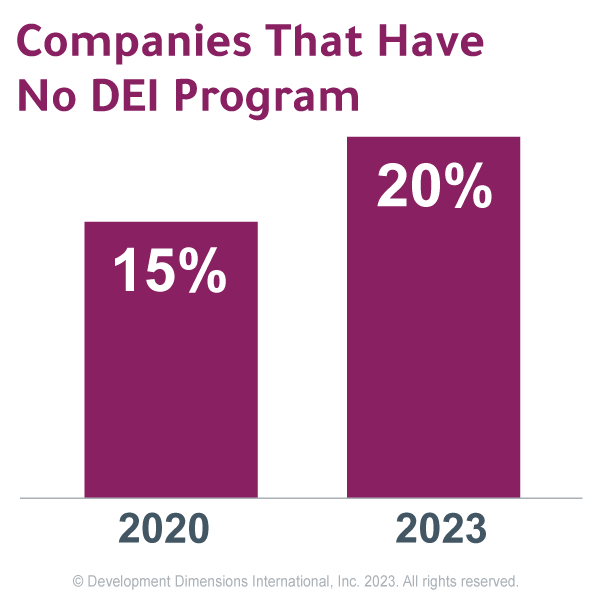
In the news and organizations, we’ve seen many companies stepping back from DEI commitments. Many companies have lost their Chief Diversity Officers. In fact, Revelio Labs found that DEI roles were cut from companies almost twice as fast as non-DEI roles. And in DDI’s Global Leadership Forecast 2023, we saw that 20% of companies said they have no DEI program, an increase from 15% in 2020.
While DEI programs have a broader scope than gender diversity alone, they are tightly linked. DDI’s Global Leadership Forecast 2023 showed that companies with strong DEI programs have at least 35% women leaders on average, compared to only 25% women leaders in companies with no or low-quality DEI programs.
So, what happens next? Are companies going to lose momentum for DEI, including their support for women in leadership? Or are companies changing their approach to make inclusion an integral part of the business?
In this piece, we’ll explore some of the statistics behind women in leadership and its impact on the business.
About Our Research on Women in Leadership
To explore our questions about inclusion and the state of women in leadership, we analyzed data collected for our Global Leadership Forecast 2023. The Global Leadership Forecast is the largest and longest-running survey of its kind. For this report, we collected data from 1,827 human resource professionals and 13,695 leaders at 1,556 organizations globally. The organizations we surveyed spanned more than 50 countries and 24 major industries.
Any statistics pulled from other data sources are noted.
The Risk of Ignoring Women in Leadership Statistics
As many organizations have faced layoffs and challenging business environments, DEI programs are often among the first to go. Companies often stop tracking their metrics. They believe that they offer equitable opportunities and that, by nature, the most qualified people will rise to the top.
But here’s what our research shows about the impact when companies have more women in leadership:
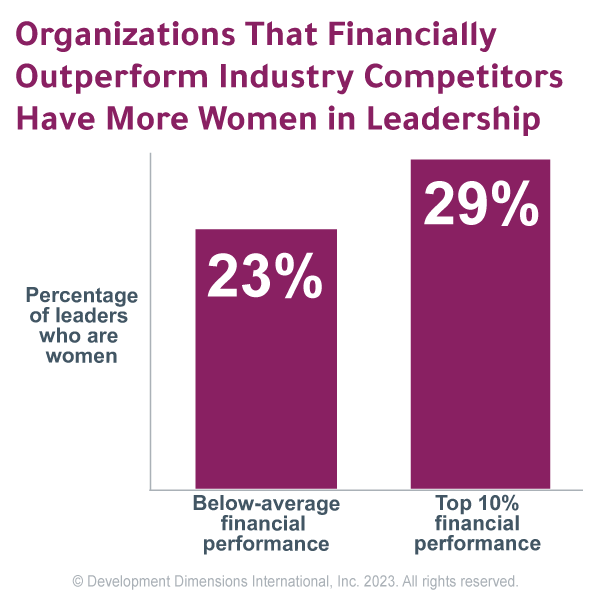
- Women impact the bottom line: Companies in the top 10% for financial performance have more women leaders, with 29% women leaders compared to only 23% women leaders in underperforming companies.
- Underperforming companies have fewer women leaders: Companies that are underperforming have seen their percentage of women leaders drop from 27% in 2020 to 23%.
- Top-performing companies are accelerating more women leaders: High-performing companies also tend to have more women in their high-potential pools who are being developed to take over higher-level roles. However, even in top-performing organizations, the representation of women is low. On average, women make up only 23% of high-potential pools at top-performing organizations. The numbers are even smaller in underperforming organizations, where only 14% of high-potential leadership pools are women.
- Women leaders support bench strength: Many companies are also highly concerned about leadership bench strength, a key indicator of the company’s ability to grow and face future challenges. Women are at least 28% of high-potential pools in companies with high bench strength, compared to only 18% in companies with low bench strength.
The data shows that organizations that ignore their statistics on women in leadership in favor of more pressing business concerns are likely doing more harm than good. In most cases, ignoring their organization’s women in leadership statistics will weaken their chances of future success.
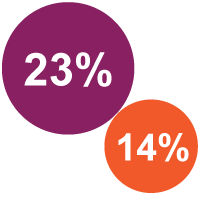
On average, women make up only 23% of high-potential pools at top-performing organizations. The numbers are even smaller in underperforming organizations, where only 14% of leaders in high-potential pools are women.
DDI Global Leadership Forecast, 2023
The Push Toward Broader Inclusion
Other companies may be moving away from DEI programs that target specific under-represented groups because they are pushing toward broader inclusion. We’re encouraged that many of these companies are taking increasingly nuanced views on identity.
They recognize that there are many ways in which facets of identity intersect—including gender, age, ethnicity, race, sexual orientation, background, etc.—that create a unique experience for each person. As a result, they are working to embrace inclusion on a broader scale, focusing on fairness, trust, belonging, psychological safety, and more.
However, a broader focus is not necessarily a reason not to track the representation of women in leadership. In fact, DDI’s data show that having more women in leadership supports a more inclusive environment for everyone.
According to our research:
- More women leaders support a more inclusive environment: Organizations with an above-average* number of women leaders are 1.9x more likely to be rated as having an inclusive culture than those with fewer women.
- Inclusion benefits everyone: Surprisingly, in male-dominated companies (those with fewer than the average number of women leaders), more men than women recognize a lack of inclusivity. In these organizations, 39% of men say their culture is not inclusive of different perspectives. Meanwhile, only 24% of women say the same. Comparably, only 22% of men say their culture isn’t inclusive in organizations with greater than the average number of women leaders.
As companies seek to create more inclusive cultures for everyone, a clear representation of women leaders is one of the leading indicators to consider.

Organizations with an above-average* number of women leaders are 1.9x more likely to be rated as having an inclusive culture than those with fewer women.
DDI Global Leadership Forecast, 2023
*“Above average” means having 30% or more women in senior roles and 40% or more women in leadership roles at lower levels.
An Opportunity to Drive Engagement and Retention, Particularly for Women in STEM
In our survey of CEOs, the top-three concerns that kept them up at night were all related to their people:
- Attracting and retaining top talent
- Developing the next generation of leaders
- Maintaining an engaged workforce
Concerns varied more widely among lower-level leaders in the organization. However, women were significantly more concerned about managing an engaged workforce than men, and those results were even more prominent in STEM-related fields.
Our research showed that:
- Women leaders focus on employee engagement: Globally, women are 1.4x more likely to say they are most concerned about maintaining an engaged workforce than men.
- Women leaders in STEM fields are particularly concerned about engagement: Women in both manufacturing and technology and electronics industries are 1.8X more likely to be concerned about managing an engaged workforce than men. Similarly, women in healthcare (a STEM-adjacent industry) are 1.6X more likely to be concerned about managing an engaged workforce than men.
- Men leaders are more concerned about emerging technologies: Men are 1.3x more likely to say they are most concerned about succeeding with emerging technologies compared to women, especially in the tech industry. In the field of technology and electronics, men are 1.7x more likely to say they are most concerned about succeeding with emerging tech compared to women.
Of course, most companies require both a human and technological edge to be competitive, particularly in STEM fields. However, companies may note that women leaders may be playing a pivotal role in their talent strategy, and they should ask themselves if they are doing enough to level the playing field for women in STEM.
Women Fall Behind in Key Developmental Experiences
Some of the best news from our research is that we are seeing more equity in the developmental experiences offered to men and women leaders. However, there are a few key opportunities where women are behind men leaders.
1. Mentorship
Women should be included in mentoring programs that allow them to learn and grow into new roles and promotions. Yet, women leaders are less likely to have a formal mentor assigned to them in their careers.
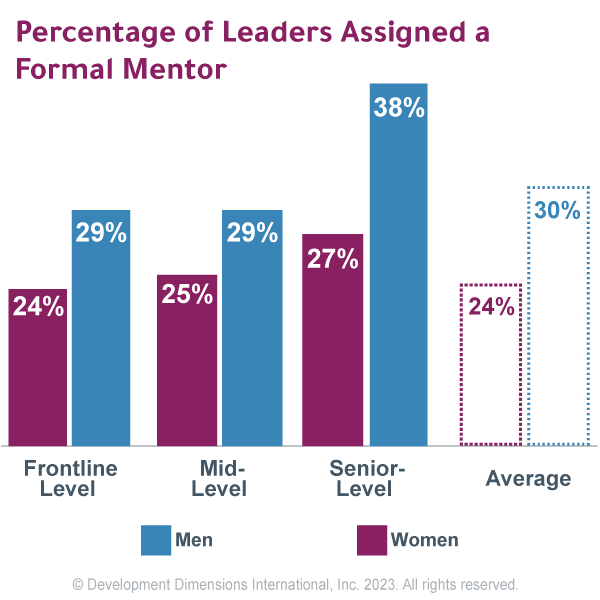
- On average, only 24% of women leaders have had a formal mentor, compared to 30% of men.
- The mentorship gap widens at higher levels. At the senior level, only 27% of women have had a formal mentor, compared to 38% of men.
Our Recommendation: It is important to educate early-career women on the importance of networks, mentors, and sponsors and for organizations to create formal pathways for these connections. Furthermore, we must measure the success of mentor/sponsor programs, particularly as the hybrid work world has become the norm, and the ability to strengthen these connections creates further challenges.
2. Manager Feedback
One of the most critical ways leaders grow is through career-advancing feedback from their manager during their development process. While many companies can improve their efforts in this area, it’s more common for men to get feedback than women.
- After going through leadership training, 57% of women say they get feedback from their managers compared to 62% of men.*
*Source note: This data is from DDI’s aggregate Impact Evaluation data, 2024.
Our Recommendation: To create fairness, organizations should institute formal review processes to create a culture of feedback that focuses both on development and career prospects. In the absence of this, or in addition, we recommend that women actively seek feedback and don’t settle for perfunctory statements on performance. Instead, push for specific feedback on behaviors and suggestions for alternative actions.
3. Profit and Loss Responsibility
Profit and loss responsibility essentially makes a leader a “mini-CEO.” It requires a leader to manage a business unit’s profitability, including strategies to increase revenue, minimize expenses, and allocate resources. Given how crucial this skill is to lead the business, managing a P&L is a key development opportunity for leaders who want to become senior executives and members of the C-suite. However, women leaders are less likely to get the chance to lead a P&L.
- Among men leaders at the senior executive and C-suite level, 79% had managed a P&L function. However, only 67% of executive and C-suite women leaders reported having P&L responsibility.
Our Recommendation: Remove this blocker to career advancement by giving women alternative opportunities to prove bottom-line impact and hone their business acumen.
4. Transition Support
One of the most vulnerable moments for leaders is transitioning into a new leadership role. When leaders struggle in their transitions, they are less likely to be engaged and succeed in their roles as leaders long term.
Our research shows that in their current roles:
- Women were 12% less likely than men to receive leadership skills training and 15% less likely to be assessed to gain insights into their strengths and development gaps as leaders.
Our Recommendation: Clearly, an equitable pipeline of leaders is directly linked to core organizational actions to recruit, advance, sponsor, and retain women (especially women of color) and the creation of critical experiences (e.g., equal opportunities to P&L roles) that will help women advance to senior positions. It is vital that organizations audit their current processes for gender equity and take purposeful actions to close gaps immediately.
Retaining Women Leaders
While the business case for more women leaders is strong, many companies struggle to retain talented women.

Women are 1.5x more likely to feel they have to leave their companies to advance their careers than men.
DDI Global Leadership Forecast, 2023

The risk of women leaders leaving is especially high at higher levels of the organization, especially for women who represent a minority background.
- At senior levels of the organization, 29% of men executives say they plan to leave their companies to advance their careers, compared to 40% of women. And 49% of minority women say they plan to leave.
In many cases, the challenge is more than just a lack of opportunity. Instead, the biggest driver of women’s departure is how much they trust senior leaders in their organizations.
- Among mid- and senior-level women, 70% of those who didn’t trust their senior leaders said they intended to leave, compared to only 26% who trusted their senior leaders.
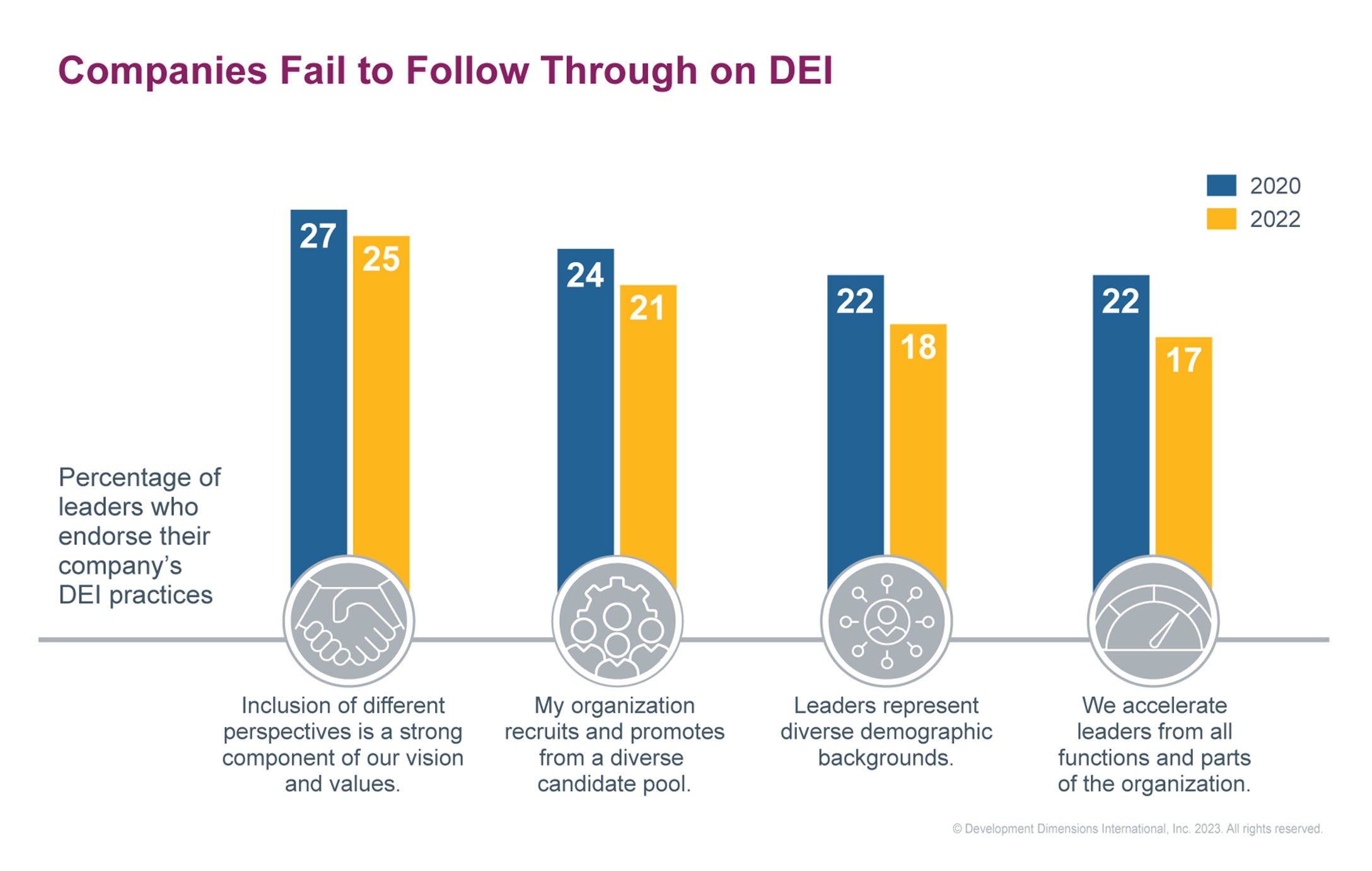
Part of that lack of trust may be related to companies’ failure to follow through on DEI initiatives.
- Between 2020 and 2022, there was an 18% decrease in leaders endorsing their company’s overall DEI efforts.
These percentages reflected disappointments across every DEI metric. In addition, the research also revealed some generational disparities in how leaders felt about these metrics, with “Gen X” leaders reporting the most distrust in DEI.
The clear lesson is that companies that want to retain women leaders must clearly show their investment in their development and career growth. Even more importantly, they need to follow through on what they promise.
Creating a Better Future for Women in Leadership
There’s no question that we have cause to celebrate the progress of women leaders in recent years. And it’s inspiring to see so many organizations working to integrate DEI into their core talent strategy.
However, we haven’t come so far that it’s time to stop looking at the statistics behind women in leadership. When we dive into the data, we still see how much work is left to truly create workplaces that enable women to thrive.
Companies that pay attention to the data and make DEI a core part of their business strategy will thrive.
To learn more, watch our on-demand webinar, “Inspire Inclusion: A Better Future for Women in the Workplace.”
Dr. Tacy Byham is the CEO of DDI. While not leading strategic execution, she enjoys her direct engagements with clients to ignite change for women leaders, overcome burnout, and foster DEI. She is pleased to report that DDI’s global leadership bench is 62% women.
Stephanie Neal, M.A., leads DDI’s Center for Analytics and Behavioral Research (CABER), where she and her team manage strategic market research and trend studies on leadership in the workplace.
Rosey Rhyne is a senior research manager on DDI’s Center for Analytics and Behavioral Research (CABER) team, where she applies her background in I/O psychology and people analytics to better understand how to improve the leadership and employee experience.
Topics covered in this blog

